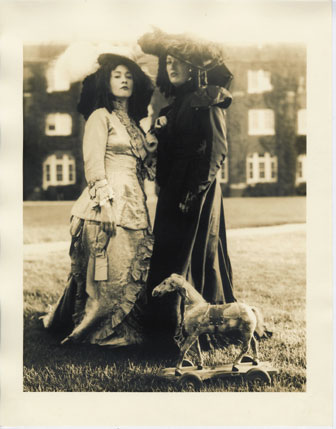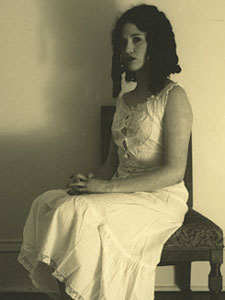VISUAL ART: What’s Old Is New Again
Art critic Mason Riddle offers her take on the Hennepin History Museum's soon-to-close photography exhibition which attempts to bring the organization's historic fashion collection into the present with mixed results.


STUDIES FROM LIFE: Costume and Object Portraits by Timothy G. Piotrowski is a curious, idiosyncratic exhibition–part period room and part private vision–which attempts to reinvigorate the past into the present. Conceived by Hennepin History Museum (HHM) curator Jack Kabrub, Studies features thirty-two of Piotrowskis silver gelatin prints showcasing the HHMs Victorian costume collection as worn by contemporary models. The sepia-toned photographs capture well enough the air of the era, through their subtle color and the artists deft hand with visual details that succeed in giving them the appearance of vintage prints. Moreover, Piotrowskis printing or matting of the images in unconventional formats (circles, ovals, octagons, or with arched borders) along with the inclusion of three mannequins in Victorian dress, including one in a two-piece wedding dress from 1885, securely links this adventure to the past. In theater, this would be method acting at its best.
Meticulously evoking a former time, the small-scale images feature models in an array of costumes and various stages of dressand undress. Seated Miss Katherine with Broad-hat and Long Cape, 1895, depicts Miss K. saucily naked from the waist down, excepting her black strapped, thick heeled shoes. Several photographs with an erotic tinge depict two or three women sharing a private, languid moment in their chemises or slips, as in Victorian Women Dressing 1880, or revealing the elaborate construction techniques of their hoops and other hidden accoutrements, as in Young Victorian Woman Anonymously Displays Her Undergarments, 1875. The portrait in this group, Victorian Nicole in Pleated Dress, is a striking image of the model leaning against a table holding the knife-pleated skirt of her dress out to the side, like a huge fan.
Not all of the images are interior shots. In Summer Eves 1906, three fashionably dressed women hover around an antique automobile. In the similar, pastoral Summer Eves Several Women Pose in a Wooded Setting with 1905 Automobile, the models do just that. In Alexandra, Marian and Manuel with a 1935 Racer and 1935 Racer and Marcel with Waved Hair, the women are dressed in classic period swimwear boating in an enviable, classic craft. One image memorializes still another diversion typical of the period: what could be more Victorian than a woman with a new-fangled bicycle?
While Piotrowskis individual images are often intriguing, occasionally provocative and deftly executed, Studies overall is period room overkill. The exhibition, installed in an intimate parlor-like room with a large fireplace in the historic 1917 Christian mansion, home of HHM, seems overly self-conscious and staged. The walls and millwork are painted a dark moss green, the windows are tightly drawn with blinds and, at the foot of the title wall, a mannequin in Victorian dress reclines on a rug surrounded by pillows, stacks of books (Greek Lyric Poets, Art & Artists Illustrated) and a large American Arts and Crafts ceramic jardinière.
The print titles and didactic panels only add to the Victorian play list. Although they do supply some curatorial context, most of the descriptions would have benefited from an editor’s touch. Too often the affected writing style one is drawn to wonder about the lives of those who wore the garments, or when discussing the motivation for the project, so that they (costumes) do not take their dying breath lying in a box in a darkened storage room, – enervates the projects overall efforts to bring the past into the present. (Also, when Piotrowski writes Victorian garments had eluded my camera because .. someone should have pointed out that garments dont elude anything, although people do.) These descriptions unwittingly undermine the labor-intensive process behind the work on viewbecause they seem to try to pass off the photos as somehow actually vintage, the accompanying text inadvertently diminishes the photographer’s skill and ingenuity to a charade, keeping both the costumes and images in the past rather than giving them a current place. These contemporary photographs deserve to be lauded as such. What’s more, because the show is poorly illuminatedperhaps also for contrived effectthe photographs are difficult to read, whether you’re trying to focus on the details of the garments or the quality of the images, themselves.
It is admirably inventive to tackle such a project this way, asking a contemporary photographer to interpret a museums historical costume collection on live models, thereby injecting new life into the garments and increasing their visibility to a wider audience. But the ambiance of Studies is stifling, particularly so in the rather dusty environment of the HHM. Just as contemporary buildings, if well designed, can enliven and give visual interest to historic neighborhoods, Piotrowskis photographs could have benefited from a more neutral, contemporary installation. Light-colored walls and some natural illumination, or at least better artificial lighting, would have infused the body of work with a vitality and lent it greater visual impact. Such treatment would have also underscored why it is always important to revisit historic work with contemporary eyes. In the end, although it’s definitely worth a visit if Victorian clothing or photography is of interest, Studies is, ultimately, more a period masquerade than the informed and enlightened case study it could have been.
What: Studies From Life: Costume and Object Portraits by Timothy G. Piotrowski
Where: Hennepin History Museum, Minneapolis, MN
When: Exhibition closes September 28
Admission is FREE and open to the public
About the writer: Mason Riddle is a critic and writer on the arts, architecture, and design. She is the current president of the Visual Arts Critics Union of Minnesota.